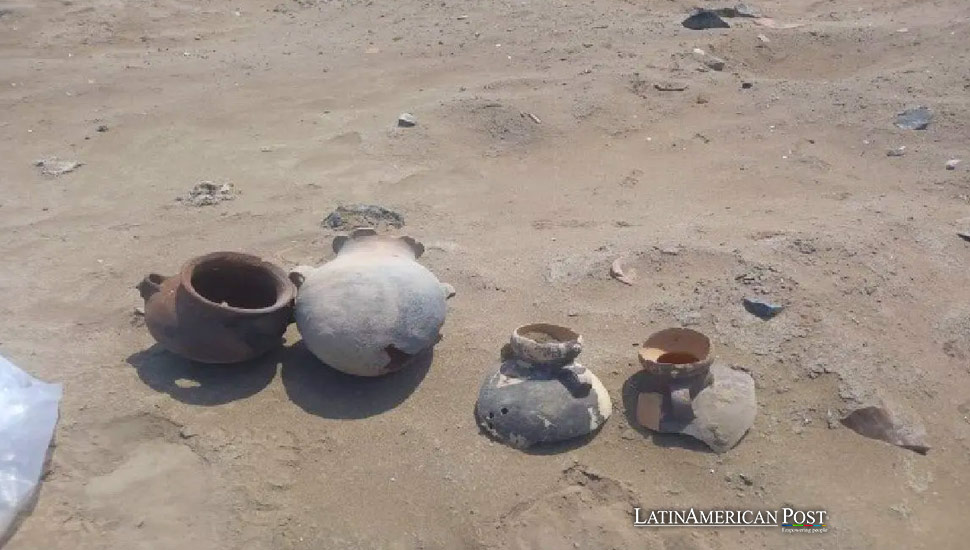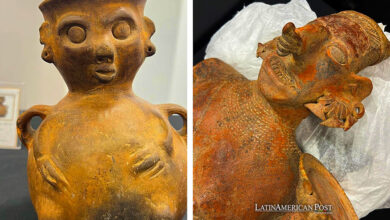Scientists Unearthed Ancient Vessels in Peru

A team of Peruvian archaeologists recently unearthed ten pre-Hispanic ceramic vessels dating back six centuries, shedding light on the Chancay culture in Lima’s northern region, the Ministry of Culture reported.
In a remarkable display of cultural preservation and archaeological prowess, a group of Peruvian archaeologists has uncovered ten ancient ceramic vessels in the Lauri archaeological site in Chancay, located in the Huaral region of the Lima department. Approximately six centuries old, these artifacts offer a window into the life and times of the Chancay culture, which flourished during the Late Intermediate Period (1100 AD – 1450 AD) in northern Lima.
Ministry of Culture Unveils Remarkable Find
The Ministry of Culture announced this significant find on a Saturday, emphasizing its importance in understanding the complexities of pre-Columbian societies in Peru. The Chancay culture is known for its distinctive art and textiles, and these vessels provide further insights into their daily lives and practices.
The excavations were conducted by specialists from the Directorate of Recoveries (DRE) of the General Directorate for the Defense of Cultural Heritage in collaboration with staff from the District Municipality of Chancay. This team worked meticulously to ensure that each piece was recovered with the utmost care to preserve its integrity and historical value.
The vessels, including jugs, pots, and plates, were crafted using traditional modeling techniques and molds, a testament to the advanced ceramic skills of the Chancay artisans. The color scheme of the pottery predominantly features black and white, which were typical of the period and region.
Challenges and Significance of Discovery
Upon initial examination, it was evident that these artifacts had suffered significant wear and tear. Some were notably deteriorated and fragmented, likely due to adverse environmental conditions or previous rough handling. Despite these challenges, the discovery marks a crucial step in piecing together the cultural jigsaw of Peru’s ancient civilizations.
Following their recovery, the vessels were transported to the Ministry of Culture’s institutional headquarters. Here, they will undergo further protective measures and detailed analysis to assess their historical significance and ensure their preservation for future generations. The Ministry plans to eventually register these items officially and declare them protected heritage.
The discovery was part of a broader inspection initiative at the cultural site, including the Pampa Libre Archaeological Site. This action was in response to a report made through the Ministry of Culture’s virtual platform by a concerned citizen about illegal excavations aimed at illicitly extracting movable cultural goods—a practice locally known as “huaqueo.”
The Ministry of Culture has used this opportunity to call upon the public to assist in protecting and defending the nation’s heritage. They encourage anyone who encounters or becomes aware of potential threats to cultural heritage to report them, emphasizing the collective responsibility to safeguard these invaluable assets.
Unveiling Peru’s Rich History
This event not only highlights the rich historical tapestry of Peru but also underscores the ongoing challenges in protecting such treasures. With each artifact unearthed, historians, archaeologists, and the general public gain a deeper understanding of the civilizations that once thrived in modern-day Peru. As the country continues to unearth its buried histories, these efforts remind us of the delicate balance between preserving the past and protecting the future.
Also read: City of Gold, City of Peril: Life at the Edge in Peru’s La Rinconada
Through these discoveries, Peru reinforces its commitment to its cultural legacy, showcasing the profound connections between its present and the ancient past. As the analysis of these vessels continues, each finding will contribute to a broader narrative of the Chancay culture, offering insights that transcend time and continue to inform and inspire.





